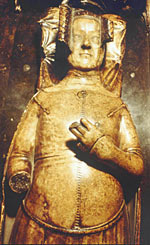sources » Philippa of Hainault
Philippa of Hainault
Lineage
Richard II's grandmother, Philippa of Hainault (1310/15-1369), was the daughter of Count William the Good of Hainault and Holland. Her mother, Jeanne de Valois, was a granddaughter of Philippe III of France and cousin to Edward II's estranged queen, Isabella.
Betrothal and marriage
Philippa was betrothed to the future Edward III in 1327, an alliance contracted against the wishes of Edward II by the queen and her lover, Roger Mortimer, to win support for their invasion of England. Nonetheless, the match between Philippa and Edward seems to have been loving and companionate. Philippa accompanied Edward in the 1330s and 1340s on his expeditions to Scotland and on the early campaigns of the Hundred Years War. They had at least twelve sons and daughters, nine of whom survived infancy. Their eldest son, Edward, Prince of Wales, Richard II's father, later known as the Black Prince, was born in 1330, their youngest, Thomas of Woodstock, in 1355. Their third son, Lionel, was born in Antwerp in 1338 and their fourth, John (of Gaunt), at Ghent in 1340.

Jean de Liège, Tomb effigy of Philippa of Hainault, alabaster (London, Westminster Abbey)
Philippa as patron
Philippa spent her early years at the cultured Hainault court. She seems to have had well developed literary tastes and perhaps a real interest in learning. For New Year 1333 she gave Edward a ewer enamelled with figures from epic and romance poetry. Among manuscripts associated with Philippa is a richly illuminated compilation now in the national library in Paris (MS fr. 571). She was the patron of the chronicler, Jean Froissart, who first arrived in England from Hainault in 1362. He wrote a lament on the queen's death in 1369. In 1341 one of her chaplains, Robert Eglesfield, founded in Oxford the future Queen's College, but placed it under the queen's protection. She used her influence on its behalf, especially after Eglesfield's death. Some of Philippa's jewels and plate are almost certainly listed among Richard II's treasure, but none is known to survive today. Her alabaster tomb in Westminster Abbey is our best witness to her patronage. It stands to the east of Edward III's monument on the south side of the Confessor's chapel and was commissioned in 1367, during Philippa's lifetime, from Jean de Liège of Brabant. The bronze figures of angels, however, were cast by John Orchard in 1376. Philippa's effigy represents a 'realistic' rather than an idealised image of the ageing queen. This was an innovation in English tomb sculpture. Jean de Liège had already worked for the French court. He had executed on the orders of Charles V the effigies of Blanche and her sister, the king's baby daughters. He later carved the effigies of Charles IV (d. 1328) and his widow, Jeanne d' Evreux (d. 1371), for the French royal mausoleum of Saint-Denis.
